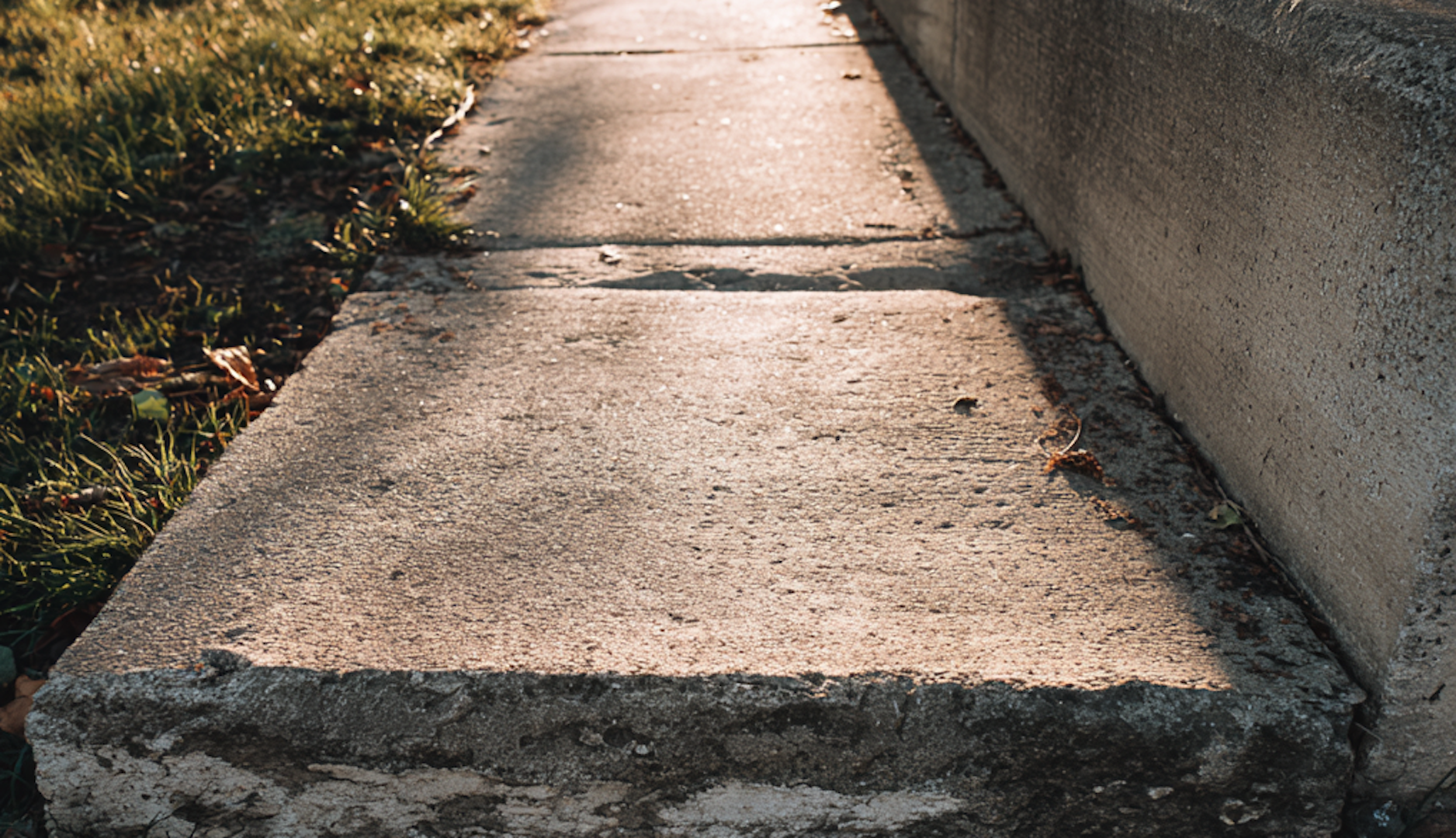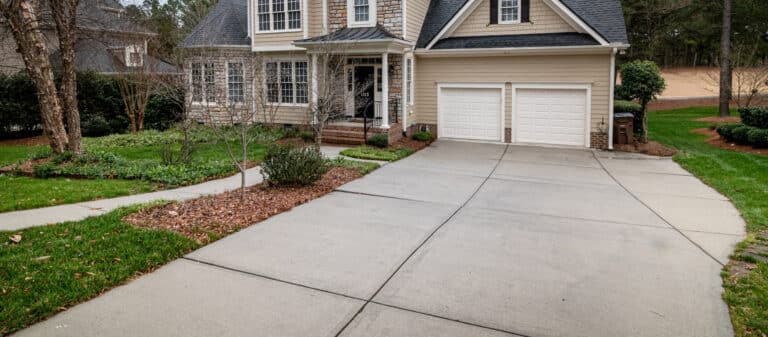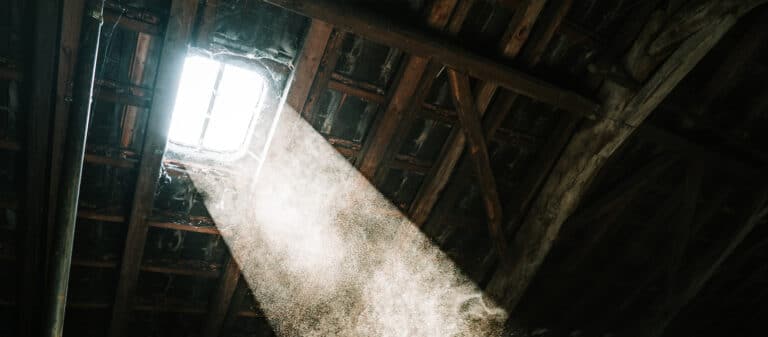Have you recently installed a concrete driveway or patio in the last few years and noticed that it’s starting to crack and buckle?
While concrete, if poured correctly, is a durable product, environmental factors, such as poor soil compaction, erosion, and even the soil quality underneath, can impact its longevity.
In areas like Northeast Pennsylvania, where the rapid transition from hot to cold causes soil expansion and tree roots are ubiquitous, it’s easy to experience sagging, cracked, or uneven concrete even a few years after it’s been laid.
Fortunately, there are lots of affordable options to repair sinking concrete, including polyurethane lifting. Nevertheless, understanding and addressing the root cause of sinking concrete will help your repairs last longer and give you peace of mind.
1. Poor Soil Compaction During Construction
One of the most common (and preventable) causes of sinking concrete is poorly compacted soil at the time of construction. If the base layer under a slab wasn’t tightly packed, it can settle unevenly over time, leading to voids and shifts in the slab above.
Polyurethane foam injection or void filling is often the best solution. This process involves drilling small holes and injecting a lightweight expanding foam beneath the slab to fill voids and lift the concrete back to its original position.
To prevent the issue from reoccurring, ensure a properly compacted gravel or sand base is used and tested before pouring.
2. Erosion From Poor Drainage
Water is one of concrete’s worst enemies, especially when it flows beneath a slab. Inadequate downspouts, sprinklers, or poor grading can allow water to wash away the soil underneath your concrete over time, leading to the issues described above.
The first step is to fix the source of the water intrusion. This might involve redirecting gutters, regrading the landscape, or installing French drains. Once drainage is under control, you can use polyurethane injection to fill the void and lift the slab.
For future reference, pay attention to water pooling near concrete surfaces after rain, especially your foundation. It’s a sign that the area may be at risk for erosion.
3. Tree Roots and Vegetation Issues
Pennsylvania derives its name from Penn’s Woods, meaning that trees are a major part of PA’s climate and geography. Unfortunately, large trees planted too close to concrete can absorb significant amounts of moisture from the soil, causing it to dry out and shrink.
As the soil volume decreases, a gap under the slab is created. In other cases, roots may actually lift or crack concrete from below.
If the issue is root dehydration, you may need to water the area more evenly to stabilize soil conditions. If roots are causing displacement, the tree may need to be pruned or removed, followed by repair or lifting of the concrete.
For long-term peace of mind, avoid planting large-rooted trees (like maples or willows) near walkways, patios, or foundations. Consider installing root barriers to prevent underground growth from reaching the concrete.
4. Expansive or Clay-Rich Soil
While more common in the western half of the state, expansive soils are still commonly found in the valleys littered throughout NEPA. These soils can swell when wet and shrink when dry, causing slabs to shift, settle, or crack as the ground beneath them rises and falls with the weather.
Soil stabilization methods like chemical grouting can be used to solidify and reduce moisture movement in clay-heavy soils. For surface-level issues, polyurethane foam injection can help re-level the slab and accommodate some movement.
Be sure to maintain consistent moisture levels around your property. Avoid overwatering during dry spells, which can worsen shrinkage in clay soils.
5. Heavy Loads or Excessive Weight
Concrete may be strong, but it’s not invincible. If heavy vehicles, industrial equipment, or storage items are placed on a slab not designed to support the weight, the concrete can compress the soil below and sink.
In cases where the damage isn’t severe, lifting techniques can correct the level of the slab. In more extreme scenarios, the slab may need to be replaced with thicker concrete or reinforced with rebar and deeper footings.
If you’re using a slab for something it wasn’t originally designed for (like parking an RV on a patio), consult a professional about reinforcement to avoid long-term damage.
6. Frost Heave and Seasonal Freezing
In colder climates like NEPA, water in the soil beneath concrete can freeze and expand, pushing the slab upward. When the ice melts, the soil settles back, but the concrete may not return to its original position. Over time, this freeze-thaw cycle can lead to misalignment or collapse.
For minor movement, lifting with foam or mudjacking can correct the issue. Insulation can be added under the slab or along the foundation for long-term durability to prevent frost penetration.
To prevent these issues, slabs should be poured on gravel bases that allow for drainage, and footings should extend below the frost line.
7. Undetected Plumbing Leaks
Finally, underground leaks from pipes, irrigation lines, or septic systems can saturate the soil beneath concrete. Over time, this leads to soil erosion or expansion that shifts the slab out of alignment.
Detect and fix leaks using pressure tests or camera inspections. After resolving the plumbing issue, voids left behind can be filled and slabs re-leveled using lifting technologies.
Periodically check water bills for unexplained spikes. It could signal a hidden leak affecting the soil beneath your concrete.
Causes of Sinking Concrete & Solutions
Cause | Solution |
Poor Soil Compaction | Polyurethane foam injection or mudjacking |
Water Erosion | Fix drainage, install French drains, re-level slab |
Tree Roots | Root barriers, strategic watering, slab lifting |
Expansive Soil | Soil stabilization, consistent moisture control |
Heavy Loads | Reinforced concrete or weight redistribution |
Frost Heave | Add insulation, re-level slabs, proper sub-base |
Plumbing Leaks | Detect leaks, fix lines, re-lift concrete |
Don’t Ignore the Early Signs of Sinking Concrete
Many property owners wait too long to address concrete settlement, making repairs more difficult and expensive. Ignoring early signs of sinking concrete can lead to trip hazards, water intrusion, and much higher repair bills down the road.
The good news? Many of the solutions to lift and level concrete are faster, more affordable, and less invasive than most people expect.
In most cases, you don’t need to replace the entire slab. Advanced methods like polyurethane injection can restore levelness and strength within a matter of hours, not days.
FAQs
How can I tell if the problem is serious enough to fix now?
If you notice visible gaps under the slab, pooling water, tripping hazards, or worsening cracks, it’s best to address them immediately. Waiting can lead to more damage and higher repair costs.
Can I fix sinking concrete myself?
Minor surface-level cosmetic issues might be addressed with patching or resurfacing kits, but actual lifting and void filling should be handled by professionals. These jobs require specialized equipment and materials, like polyurethane foam or slurry pumps.
What’s the difference between mudjacking and polyurethane injection?
Mudjacking uses a heavier cement-based mixture to lift the slab, while polyurethane injection uses a lightweight expanding foam. Polyurethane cures faster, is less invasive, and is better for long-term results, though it may cost more.











